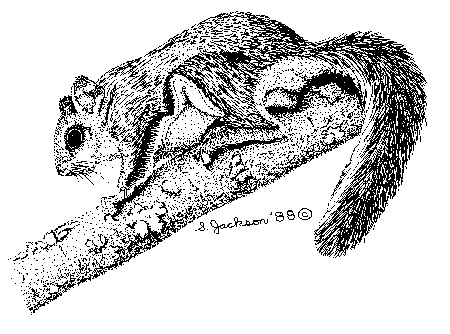Flying Squirrels
Southern Flying Squirrel (Glaucomys volans)
Northern Flying Squirrel (Glaucomys sabrinus)
 Habitat: Mature deciduous or mixed deciduous/coniferous forests with an abundance of various nut-producing trees.
Habitat: Mature deciduous or mixed deciduous/coniferous forests with an abundance of various nut-producing trees.
Weight: Southern flying squirrel, 1.8 to 2.5 ounces. Northern flying squirrel, 2 to 4.4 ounces.
Length: Southern flying squirrel, 8 to 10 inches. Northern flying squirrel, 9.8 to 11.5 inches.
Food: Acorns, nuts, seeds, berries, blossoms, mushrooms, moths, beetles, and small birds and their eggs.
Identification: Flying squirrels have soft, gray-brown fur on the back and sides, with white underparts, a flattened tail and large, dark eyes for night vision. The northern flying squirrel is slightly darker and redder than the southern flying squirrel. The loose folds of skin between the front and hind legs of these squirrels enables them to "fly;" they actually glide through the air on the stretched surface of this loose skin.
Range: The southern flying squirrel is found from southern Canada south to southern Florida, west to Minnesota and eastern Texas. The northern flying squirrel is found from southeastern Alaska and northern Canada south to Tennessee and west to the Pacific coast.
Reproduction: Mating occurs in late winter, and after a 40-day gestation period, an average of three to four young are born. A second breeding period occurs in the summer. The young are born blind and helpless but develop more quickly than other squirrels. By six weeks of age, they are able to forage on their own. Tree cavities and even bird houses may be used as nesting sites. The nest may be lined with shredded bark, leaves, moss, feathers, and other materials.
History in Connecticut: The southern squirrel is found throughout Connecticut, but the northern flying squirrel's range includes only the higher elevations of the northwestern part of the state. Due to their nocturnal nature, flying squirrels are seldom seen and, thus, their abundance is difficult to document. The southern flying squirrel was considered a common resident during the early 1900s and is still common today. The northern flying squirrel has never been very common in this state. There are no records available regarding the status in Connecticut of either squirrel prior to the 1900s.
Interesting Facts: Depending on the air current, flying squirrels may glide 150 feet or more from a height of 60 feet. They can turn easily at right angles while gliding and control the direction of their glide by tensing and turning their legs and body and flapping their tail. As a flying squirrel approaches its landing, the squirrel flips its tail up and holds its body back to slow the glide down, giving the squirrel ample time to position its feet for grasping the tree trunk. Flying squirrels usually land face up and often run up the tree immediately after landing.
Flying squirrels are active year-round, are highly sociable, and will feed and den together, especially during periods of harsh weather. There are even reports of flying squirrels denning with other animals, including screech owls and bats.
When feeding on tree nuts, they will characteristically make one opening in the shell to extract the meat. In contrast, other squirrels and chipmunks break the nuts into many pieces to obtain the meat. They store food for winter use in den trees or underground.
Management of Problem Squirrels: Most complaints about flying squirrels are from homeowners with squirrels in their houses. Squirrels will readily take up residence in a building if access is available to a sheltered area. Flying squirrels enter homes through small holes around dormers, ridge vents, eaves, attic vents, and similar vulnerable areas. All such holes should be closed to prevent squirrels and other animals from gaining entrance. Be sure that no squirrels are trapped inside. Adults can cause severe damage by chewing to regain entrance to reach their young. If chewing persists, heavy, half-inch wire mesh can be temporarily placed over the problem area. Trimming shrubs and vines and pruning overhanging tree limbs may discourage squirrels from causing problems in the home.
A squirrel trapped in a chimney should not be removed through the fireplace area because it might escape into the room. Instead, lower a heavy rope down the chimney to provide the means for the animal to climb out. Drop the other end of the rope to the ground to avoid another trip to the roof to retrieve it after the squirrel has left.
The trapping of squirrels can temporarily solve a persistent problem but will not help in the long run because other squirrels will soon come into an area to replace the removed animals.
For more information on the management of problem squirrels or for a referral to a licensed Nuisance Wildlife Control Operator, contact the Wildlife Division 860-424-3011.
 The Technical Assistance
Informational Series is 75 percent funded by Federal Aid to Wildlife Restoration -
Pittman-Robertson (P-R) Program. The P-R Program provides funding through an excise tax on
the sale of sporting firearms, ammunition, and archery equipment. The remaining 25 percent
of the funding is matched by the Connecticut Wildlife Division. (rev. 12/99)
The Technical Assistance
Informational Series is 75 percent funded by Federal Aid to Wildlife Restoration -
Pittman-Robertson (P-R) Program. The P-R Program provides funding through an excise tax on
the sale of sporting firearms, ammunition, and archery equipment. The remaining 25 percent
of the funding is matched by the Connecticut Wildlife Division. (rev. 12/99)

